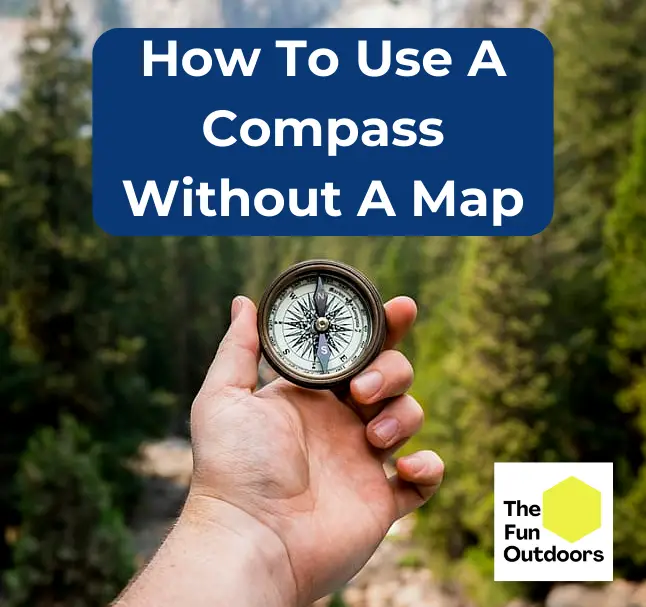How to Use a Compass Without a Map
Using a compass without a map may seem like a daunting task for those who are not familiar with navigation techniques. However, with the right knowledge and practice, it is possible to navigate through unexplored areas without a map and return home safely.
Using a compass without a map is as simple as picking a location in the distance to navigate to, adjusting your compass to that direction, keep on a straight path, and track your movement using timing or pacing.
We’ll go through everything you need to know when navigating without a compass in today’s guide.
Understanding the Compass
A compass is an essential tool for navigating in the wilderness. It helps hikers, campers, and outdoor enthusiasts find their way when they don’t have access to a map or GPS. Understanding how to use a compass without a map is a valuable skill that can save your life in an emergency.
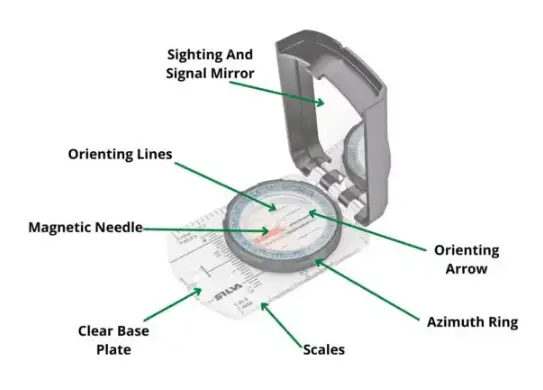
Parts of a Compass
A compass has several parts that work together to help you find your way. Here are some of the most important parts of a compass:
- Baseplate: The flat, rectangular part of the compass that you hold while navigating.
- Housing: The round part of the compass that contains the magnetized needle and the azimuth ring.
- Floating Dial: The circular part of the compass that rotates around the magnetized needle.
- Sighting Lens: The part of the compass that you look through to align the compass with a landmark or distant object.
- Magnetized Needle: The red magnetic needle that always points to magnetic north.
- Azimuth Ring: The outer ring of the compass that is marked with degrees. You use this ring to measure angles and bearings.
- Direction-of-Travel Arrow: The arrow on the baseplate that you align with your destination.
To use a compass without a map, you need to understand how to use these parts together. You also need to know how to orient the compass and take a bearing. With practice, you can become proficient at using a compass to navigate without a map.
Magnetism and Compass Use
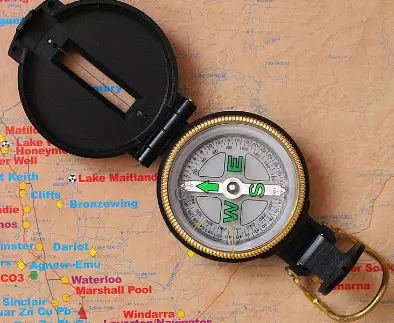
Understanding Magnetic North and True North
When using a compass, it is essential to understand the difference between magnetic north and true north. True north is the geographic North Pole, while magnetic north is the direction that the compass needle points towards. The earth’s magnetic field causes the needle to align with magnetic north, which is not the same as true north.
It is important to note that the magnetic north pole is not fixed and moves over time. This means that the magnetic declination, which is the difference between magnetic north and true north, also changes. The declination adjustment is necessary to obtain accurate readings.
Dealing with Magnetic Declination
To use a compass without a map, one must know the magnetic declination for the area they are in. The declination adjustment can be made by either adding or subtracting the declination value from the compass reading.
When the magnetic declination is west, the compass reading will be less than true north. In contrast, when the magnetic declination is east, the compass reading will be more than true north.
It is essential to note that the declination adjustment must be made before using the compass. Failure to do so will result in inaccurate readings and may lead to getting lost.
In summary, understanding magnetic north and true north and dealing with declination are crucial when using a compass without a map. By making the necessary adjustments, one can obtain accurate readings and navigate with confidence.
How To Use A Compass Without A Map
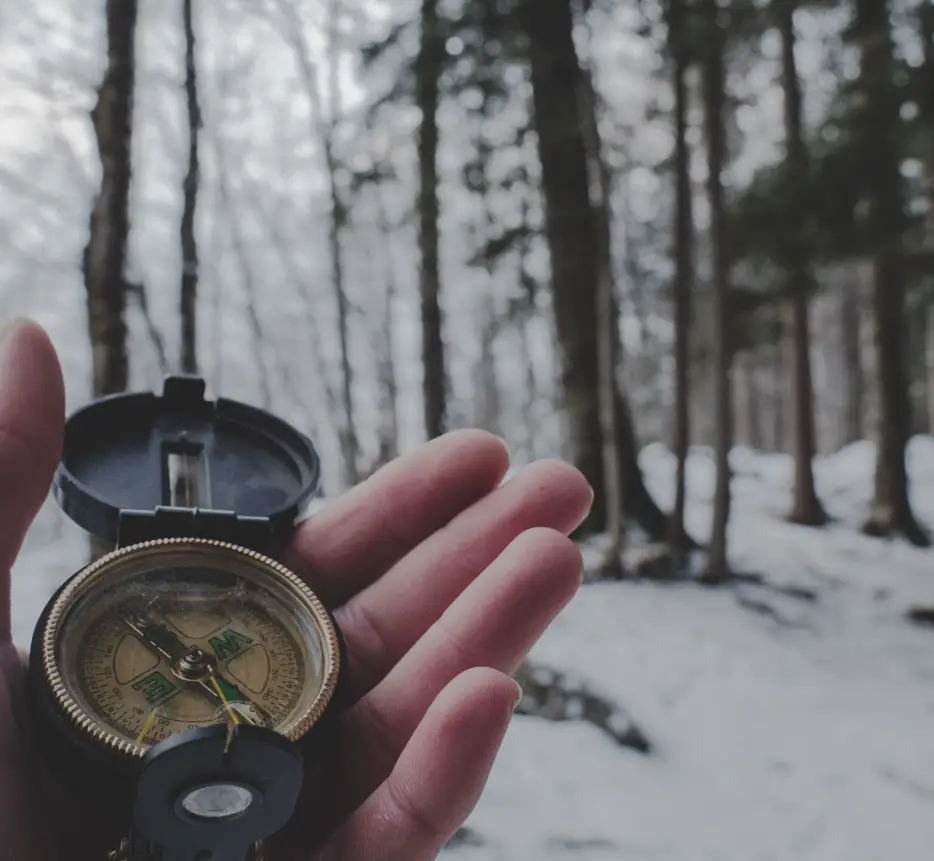
Step 1: Decide Where You Want To Go
Before using a compass without a map, it’s important to know where you want to go. Identify a landmark or destination that you can see from your current location. This will help you determine your direction of travel.
Step 2: Determine Your Direction Of Travel
Hold the compass level in your palm and align the direction of travel arrow with your destination. Turn the compass housing until the orienting lines are parallel with the magnetic needle.
Step 3: Hold The Compass Level In Your Palm
To get an accurate reading, it’s important to hold the compass level in your palm. Keep the compass away from magnetized metal objects, such as phones or watches, as they can interfere with the compass needle.
Step 4: See Which Way The Red Needle Is Pointing To
The red point on the compass needle indicates magnetic north. Check the needle to see which way it’s pointing. Rotate the compass bezel until the orienting arrow is under the red end of the needle.
Step 5: Rotate The Compass Bezel Until The Orienting Arrow Is Under The Red End
Rotate the compass bezel until the orienting arrow is under the red end of the needle. Remember the bearing number on the index line.
Step 6: Remember The Bearing Number On The Index Line
The bearing number on the index line shows the direction you need to travel. Remember this number as you begin walking towards your destination.
Step 7: Walk In The Direction Of Your Bearing
Start walking in the direction of your bearing. Keep the compass level in your palm and check the needle frequently to make sure you’re still on course.
Step 8: Use Pacing Or Timing To Track Your Movement
To keep track of your progress, you can use pacing or timing. Count your steps as you walk, or use a watch to time how long it takes you to reach a landmark. This will help you estimate how far you’ve traveled and how much further you need to go.
Using a compass without a map requires some way-finding skills and mental-mapping abilities. It’s important to practice orienteering and navigation techniques to improve your survival skills.
Remember, the North Star is a reliable landmark for finding your way at night, and coordinates can help you pinpoint your location on a map. With these tips and techniques, you can confidently navigate towards your intended destination.
Advanced Compass Techniques
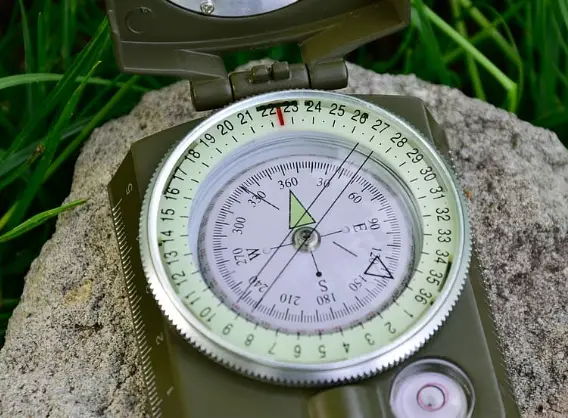
When it comes to using a compass without a map, there are a few advanced techniques that can come in handy. These techniques can help you navigate more accurately and confidently, even in challenging terrain or situations where you don’t have access to other navigation tools.
Mapless Dead Reckoning
One technique that can be useful in certain situations is mapless dead reckoning. This involves using your compass to navigate based on your current position and a known destination, without the use of a map. To do this, you’ll need to know your current position and the bearing to your destination.
Once you have this information, you can use your compass to follow the bearing and estimate the distance you need to travel based on pacing or timing.
This technique requires a high degree of accuracy in both your current position and the bearing to your destination, so it’s important to double-check your measurements and calibrate your compass regularly.
Using Natural Indicators
Another advanced technique for compass navigation is using natural indicators to help orient yourself and stay on course. This can be especially helpful in areas where the terrain is rugged or there are no distinct landmarks to guide you.
Some natural indicators you can use include the position of the sun or stars in the sky, the direction of prevailing winds, and the behavior of animals or insects. For example, in the Northern Hemisphere, the sun always rises in the east and sets in the west, so you can use this information to orient yourself and navigate in a specific direction.
It’s important to note that relying solely on natural indicators can be risky, as they can be affected by factors like weather and time of day. However, when used in conjunction with other navigation techniques and tools, they can be a valuable resource for staying on course.
Wrapping Things Up
In conclusion, using a compass without a map is a useful skill for anyone who enjoys outdoor activities such as hiking, camping, or hunting. With a basic understanding of how to use a compass, one can navigate through the wilderness and reach their destination safely.
To use a compass without a map, it is essential to understand the magnetic declination of the area you are in. This indicates the difference between magnetic north and true north on your compass. By taking into account the magnetic declination, you can accurately determine your direction and navigate to your desired location.
Pacing and timing are also important factors to consider when using a compass without a map. By counting your steps and timing your movements, you can estimate the distance you have traveled and the time it will take to reach your destination.
It is important to note that while using a compass without a map can be a useful skill, it should not be relied upon entirely. It is always best to carry a map and a compass and use them together to navigate through unfamiliar terrain.
Overall, learning how to use a compass without a map is a valuable skill that can enhance your outdoor experience. With practice and patience, anyone can become proficient in navigation and confidently explore the great outdoors.

